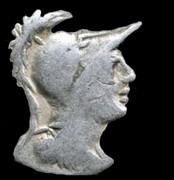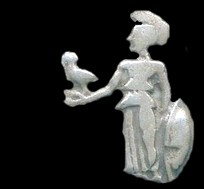 |
Minerva |
 |
 |
Minerva |
 |
Minerva was originally an Etruscan deity who was later identified with the Greek goddess Athena. At Rome she formed the Capitoline triad together with Jupiter and Juno. Minerva had a temple on the Aventine and her festivals were held on June 13 (musicians) and March 19 (Quinquatrus). Roman Minerva was patroness of all activities involving mental skill; schools; wisdom; commerce; industry; and artisans, and only later assumed the character of a war goddess. Early Republican coins, for instance the triens, depict Minerva on the obverse wearing a crested Corinthian helmet; an ear-ring; a necklace and long hair, with four pellets above her head. From the first century BC on Minerva appears among a number of charioteer gods as reverse type. Moneyers from this turbulent period increasingly portrayed gods driving chariots. The denarius left, for instance, shows Minerva in a quadriga. The date of issue, 90 BC, coincides with the passing of the Lex Julia which gave full Roman status to Rome's Italian allies during the Social war. This reverse type with Apollo on the obverse also appears frequently on coins of political rivals. |
During the late-Republic Minerva was identified with Athena Promachos, goddess of victory, and fully assumed her attributes on coins. Minerva appears frequently on Imperial coinage as a war-like goddess who guides soldiers in battle. She is usually depicted with a helmet, holding a shield and spear, sometimes a victoriola. Other attributes include the figure of an attendant owl; an olive branch; an aegis; a thunderbolt; a sceptre; a snake; or a cockerel. On an as of Claudius (below left) Minerva is shown in an upright warrior posture, advancing, with aegis, brandishing a javelin and holding a shield. In AD 82 Domitian instituted four new reverse types depicting Minerva as his patron deity. He often portrays her as an agent of Jupiter: standing, holding a thunderbolt and spear, with a shield at her feet (below centre). Sometimes Minerva is represented as the bringer of peace (albeit through conquest): on a denarius of Clodius Albinus (below right), struck under Septimius Severus, Minerva Pacifera is standing, holding an olive branch and shield. However, at his stage (196 AD) all eforts at reconciliation between Severus and Albinus proved futile. |